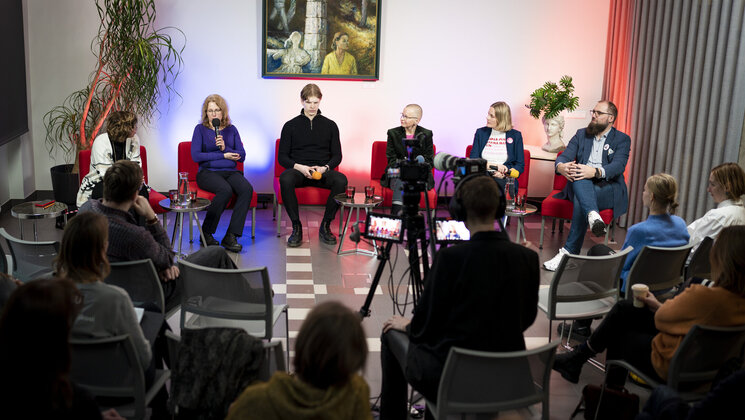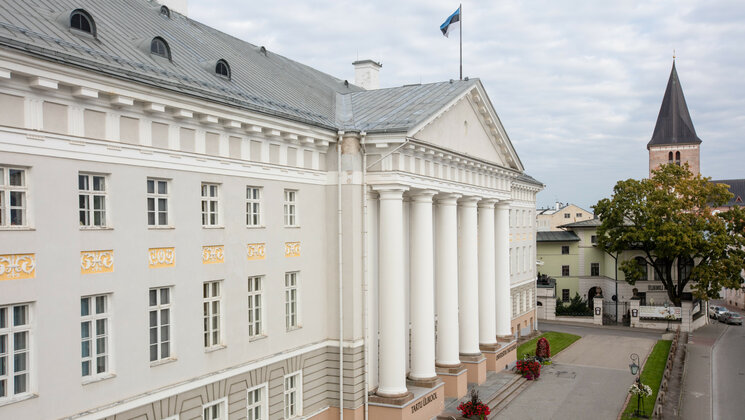-
Faculty of Arts and HumanitiesDean's Office, Faculty of Arts and HumanitiesJakobi 2, r 116-121 51005 Tartu linn, Tartu linn, Tartumaa EST0Institute of History and ArchaeologyJakobi 2 51005 Tartu linn, Tartu linn, Tartumaa EST0Institute of Estonian and General LinguisticsJakobi 2, IV korrus 51005 Tartu linn, Tartu linn, Tartumaa EST0Institute of Philosophy and SemioticsJakobi 2, III korrus, ruumid 302-337 51005 Tartu linn, Tartu linn, Tartumaa EST0Institute of Cultural ResearchÜlikooli 16 51003 Tartu linn, Tartu linn, Tartumaa EST0Institute of Foreign Languages and CulturesLossi 3 51003 Tartu linn, Tartu linn, Tartumaa EST0School of Theology and Religious StudiesÜlikooli 18 50090 Tartu linn, Tartu linn, Tartumaa EST0Viljandi Culture AcademyPosti 1 71004 Viljandi linn, Viljandimaa EST0Professors emeriti, Faculty of Arts and Humanities0Associate Professors emeriti, Faculty of Arts and Humanities0Faculty of Social SciencesDean's Office, Faculty of Social SciencesLossi 36 51003 Tartu linn, Tartu linn, Tartumaa EST0Institute of EducationJakobi 5 51005 Tartu linn, Tartu linn, Tartumaa EST0Johan Skytte Institute of Political StudiesLossi 36, ruum 301 51003 Tartu linn, Tartu linn, Tartumaa EST0School of Economics and Business AdministrationNarva mnt 18 51009 Tartu linn, Tartu linn, Tartumaa EST0Institute of PsychologyNäituse 2 50409 Tartu linn, Tartu linn, Tartumaa EST0School of LawNäituse 20 - 324 50409 Tartu linn, Tartu linn, Tartumaa EST0Institute of Social StudiesLossi 36 51003 Tartu linn, Tartu linn, Tartumaa EST0Narva CollegeRaekoja plats 2 20307 Narva linn, Ida-Virumaa EST0Pärnu CollegeRingi 35 80012 Pärnu linn, Pärnu linn, Pärnumaa EST0Professors emeriti, Faculty of Social Sciences0Associate Professors emeriti, Faculty of Social Sciences0Faculty of MedicineDean's Office, Faculty of MedicineRavila 19 50411 Tartu linn, Tartu linn, Tartumaa ESTInstitute of Biomedicine and Translational MedicineBiomeedikum, Ravila 19 50411 Tartu linn, Tartu linn, Tartumaa ESTInstitute of PharmacyNooruse 1 50411 Tartu linn, Tartu linn, Tartumaa ESTInstitute of DentistryL. Puusepa 1a 50406 Tartu linn, Tartu linn, Tartumaa ESTInstitute of Clinical MedicineL. Puusepa 8 50406 Tartu linn, Tartu linn, Tartumaa ESTInstitute of Family Medicine and Public HealthRavila 19 50411 Tartu linn, Tartu linn, Tartumaa ESTInstitute of Sport Sciences and PhysiotherapyUjula 4 51008 Tartu linn, Tartu linn, Tartumaa ESTProfessors emeriti, Faculty of Medicine0Associate Professors emeriti, Faculty of Medicine0Faculty of Science and TechnologyDean's Office, Faculty of Science and TechnologyVanemuise 46 - 208 51003 Tartu linn, Tartu linn, Tartumaa ESTInstitute of Computer ScienceNarva mnt 18 51009 Tartu linn, Tartu linn, Tartumaa ESTInstitute of GenomicsRiia 23b/2 51010 Tartu linn, Tartu linn, Tartumaa ESTEstonian Marine Institute0Institute of PhysicsInstitute of ChemistryRavila 14a 50411 Tartu linn, Tartu linn, Tartumaa EST0Institute of Mathematics and StatisticsNarva mnt 18 51009 Tartu linn, Tartu linn, Tartumaa EST0Institute of Molecular and Cell BiologyRiia 23, 23b - 134 51010 Tartu linn, Tartu linn, Tartumaa ESTTartu ObservatoryObservatooriumi 1 61602 Tõravere alevik, Nõo vald, Tartumaa EST0Institute of TechnologyNooruse 1 50411 Tartu linn, Tartu linn, Tartumaa ESTInstitute of Ecology and Earth SciencesJ. Liivi tn 2 50409 Tartu linn, Tartu linn, Tartumaa ESTProfessors emeriti, Faculty of Science and Technology0Associate Professors emeriti, Faculty of Science and Technology0Institute of BioengineeringArea of Academic SecretaryHuman Resources OfficeUppsala 6, Lossi 36 51003 Tartu linn, Tartu linn, Tartumaa EST0Area of Head of FinanceFinance Office0Area of Director of AdministrationInformation Technology Office0Administrative OfficeÜlikooli 17 (III korrus) 51005 Tartu linn, Tartu linn, Tartumaa EST0Estates Office0Marketing and Communication OfficeÜlikooli 18, ruumid 102, 104, 209, 210 50090 Tartu linn, Tartu linn, Tartumaa EST0Area of Vice Rector for Academic AffairsOffice of Academic AffairsUniversity of Tartu Youth AcademyUppsala 10 51003 Tartu linn, Tartu linn, Tartumaa EST0Student Union OfficeÜlikooli 18b 51005 Tartu linn, Tartu linn, Tartumaa EST0Centre for Learning and TeachingArea of Vice Rector for ResearchUniversity of Tartu LibraryW. Struve 1 50091 Tartu linn, Tartu linn, Tartumaa EST0Grant OfficeArea of Vice Rector for DevelopmentCentre for Entrepreneurship and InnovationNarva mnt 18 51009 Tartu linn, Tartu linn, Tartumaa EST0University of Tartu Natural History Museum and Botanical GardenVanemuise 46 51003 Tartu linn, Tartu linn, Tartumaa EST0International Cooperation and Protocol Office0University of Tartu MuseumLossi 25 51003 Tartu linn, Tartu linn, Tartumaa EST0Area of RectorRector's Strategy OfficeInternal Audit Office
Analysis of the possible impact of changing the higher education funding system has been completed at the University of Tartu

An overview of the higher education funding models of different countries and the possible impact of changing the funding system for both students and society has been compiled at the University of Tartu, to provide evidence-based data for the public debate concerning the future system of higher education funding in Estonia. The analysis is based on scientific literature published over the last 20 years.
The number of people who go to study at universities has multiplied over the last decades and caused a need for extra finances to ensure that universities could continue to offer high-quality higher education. Countries and universities are facing the problem where to get the additional money, and if it came from the learners themselves, how it would be justified and how it would affect the students.
According to one of the authors of the literature review “Models of higher education funding and the possible impact of changing the funding system”, the University of Tartu Vice Rector for Academic Affairs Aune Valk, tuition-free higher education has considerable advantages and, in view of the approach in our neighbouring Nordic countries, would be the best choice for Estonia at present. However, it may not always be fair for all learners. “We can see that poorly financed tuition-free higher education, where allowances and loans are insufficient for students to live on, leads to a decline in both quality and access, reduces students’ commitment to studies and in the long term, damages the creation of the next generation of Estonian-language academics. After analysing the experience of different countries, when planning the future of higher education funding in Estonia we can consider aspects that have not yet been discussed in university funding debates. One possible approach is a state-guaranteed, income-contingent loan system, which makes an investment in higher education secure,” she said.
This system will be introduced at the discussion seminar on 28 April, where an online presentation is made by Nicholas Barr, British economist and Professor of Public Economics at the London School of Economics and Political Science, who has been called one of the architects of Britain's higher education funding system. At the seminar, Barr will talk about the income-contingent loan system and the lessons learnt from the financing of higher education, drawing on both economic theory and the experience of other countries.
“When presented with a coherent strategy, it is a sad fact that politicians often implement only the parts that they like and, as a result, the policy works badly. A small, coherent country like Estonia has a wonderful opportunity to take a holistic approach to financing higher education, to promote the quality of the system and to provide good access for students from all backgrounds, and in doing so to become a role model for other countries”, said Professor Barr. “Students rightly have high expectations about the quality of higher education and its benefits for their future lives – these things really matter for young people.”
The analysis describes the factors affecting access to higher education, with examples from different countries. For example, university education may remain inaccessible if studying is free of charge for the students but they do not have enough money to pay rent, buy food or learning materials, or cover travel expenses. But access is also restricted if, for example, learners have not received the necessary preparation for university at the previous level of education and they are not aware of the benefits of higher education due to their poorer socio-economic background. This is why various support measures are important from the aspect of access. Good examples highlighted in the analysis include Finland (tuition-free higher education) and the Netherlands (moderate tuition fees), where higher education is highly accessible for students from different socio-economic backgrounds.
The analysis finds that compared to the 32 education systems of Europe, public funding for higher education in 2008–2017 decreased the most in Estonia, in inflation-adjusted terms, to 23.3%, while the GDP increased. The fact that higher education funding has declined at the time when GDP is growing is seen as a sign that the state risks losing its opportunity to strengthen the knowledge-based society.
Read the full analysis (in Estonian) here.
Read more similar news

03.03.2025



